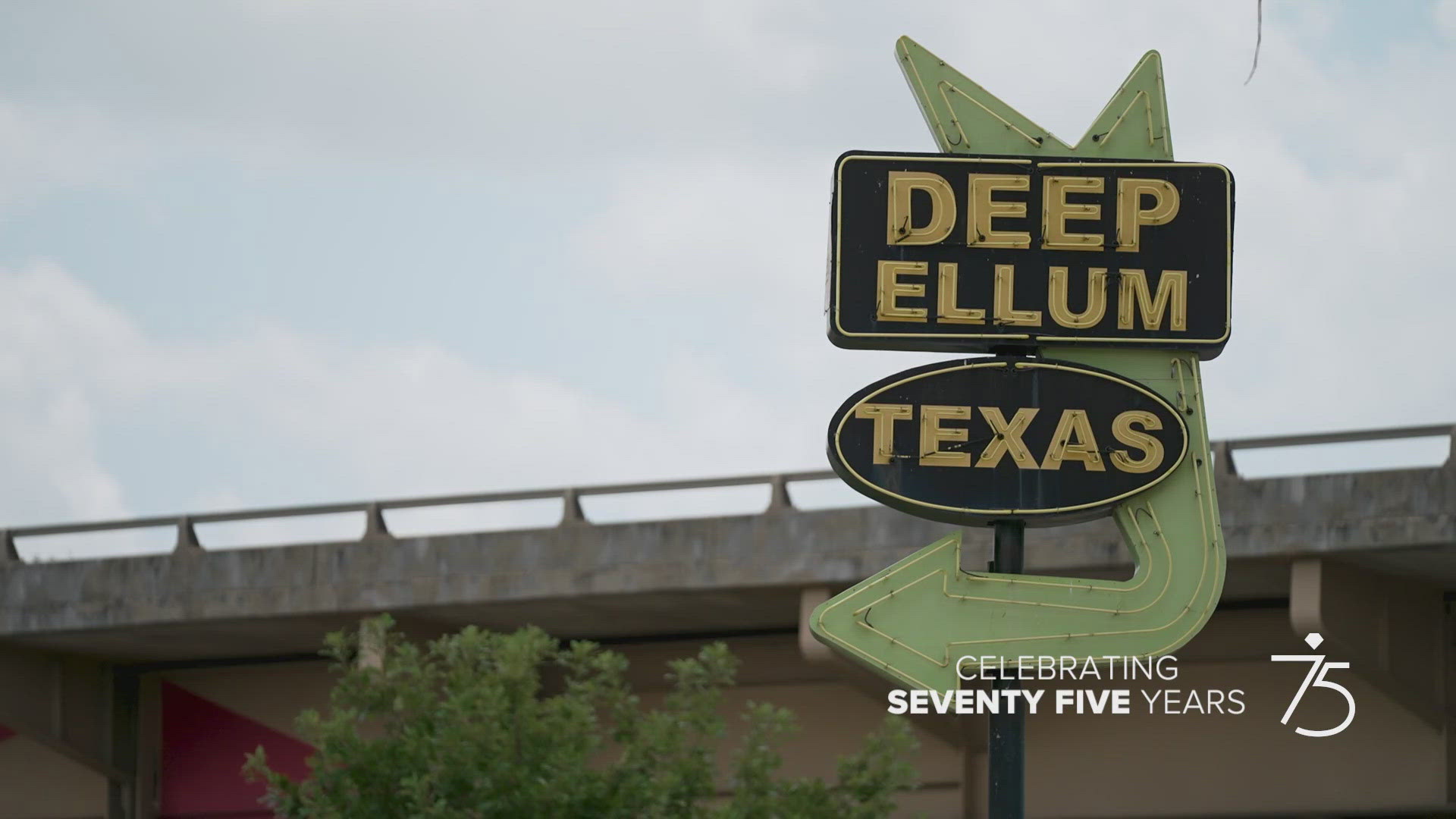DALLAS — There is no place like it. It may sit in the shadow of downtown Dallas. But Deep Ellum is the star of the show.
Where the train tracks crossed in the late 1800s, Deep Ellum was born.
"We were literally a crossroads -- a nexus of commerce, but also culture, where people dared to race-mix," says Deep Ellum Foundation Executive Director Hudiburg. "Freedmen and foreigners who could not work downtown, they worked here."
As these cultures intermingled, Deep Ellum became a hub for entertainment, too. And music. Especially music.
The blues came first in the 1910s and '20s. Iconic musicians like Lead Belly, Blind Lemon Jefferson and even the mythic Robert Johnson cultivated their legend while playing on street corners and in the many vaudeville theaters that popped up around the neighborhood.
Then, in the '80s came... well, something else.
"It was like a secret," says Jeffrey Liles, who currently works as the artistic director at the Kessler Theater and the Longhorn Ballroom. "It was the best kept secret."
Liles knows it well. He'd go on to spend much of his adult life working as a booking agent, a filmmaker, a producer and a musician. But that creative spark was lit while growing up in the neighborhood he was born in.
He was raised on stories of Deep Ellum's reputation as a counter-culture hub -- one that had reinvented itself several times over. And he was among the change agents in the '80s who cultivated a new scene centered around rock and punk music at venues like the Theater Gallery, the Prophet Bar and Trees.
"They took these empty warehouses and turned them into night spots," Liles said of himself and his peers. "Down here, you played your own music. You didn't play someone else's music. [Bands] would come out here and play, and -- boom! -- it'd be full."
Mike Snider is the owner of the AllGood Cafe, a comfort food joint he's operated since 2000. It serves as something of a community meeting center around meal time -- people from all walks of Dallas, and all stripes of Deep Ellum, gather here and break bread, sometimes with a musician plucking away on a guitar on the stage in the corner.
Snider booked shows here in the '80s and '90s, too. He remembers that era as off the books, off the radar and even a little off the handle.
"The cops drove right by our place every single night," Snider says with a nostalgic chuckle. "They had no idea what we were doing."
People make their own way in Deep Ellum. They always have.
By the '90s, Deep Ellum was once again getting internationally recognized for its music. Nirvana, Radiohead, Pearl Jam -- all the biggest names of the era played Deep Ellum at some point. Locals rocketed out of the local scene, too: Bands like The Reverend Horton Heat, Edie Brickell & The New Bohemians, Toadies, Tripping Daisy and the Old 97's not only played their hometown venues, but toured the country spreading the Deep Ellum music gospel.
"This is the place where people come to cut their teeth and make their dreams come true," Hudiburg says.
It's well-known Dallas lore that Mark Cuban started Broadcast.com in Deep Ellum, launching a career that would one day make him a billionaire and the owner of the Dallas Mavericks. Fewer know that Ford's Model T was first built here.
Deep Ellum has a tendency to come at Dallas in waves.
"It has gone through these phases of being really popular, and everything closes all at once," Liles says.
Also painted into Deep Ellum's lore are some not-so-great moments. Stories of violence, crime, shootings, economic struggles, even a brief run-in with skinhead groups roaming the streets. Hudiburg has heard all the complaints. Her job with the nonprofit Deep Ellum Foundation is centered around preserving and growing Deep Ellum. That starts with keeping it safe, she says.
"There have been several points where something's happened or crime has caused the area to dip," Hudiburg says. "And like a phoenix, it rises from the ashes."
Deep Ellum's biggest advocates argue that bad things can -- and do -- happen everywhere. Their real fear is when change is influenced from outside the area.
"Once the city realizes it's a potential cash cow, then they start looking for ways to make money off of it," Liles says. "The clock starts ticking. Ultimately what they do is squeeze out the creatives, the musicians, all the artists."
Gentrification has historically been a four-letter word in this part of town. Snider remembers the last time the city and developer types tried to exert its influence on the neighborhood back around the turn of the millennium. It's not a fond memory.
"It f***** it up," he says. "All these places closed."
These days, though, Deep Ellum is in a resurgence of a different kind. There's new development, and new high-rises. But Snider feels different about this iteration of change.
"They're customers for me," he says. "Bring 'em on."
As for young creatives and the music they make? It hasn't gone anywhere.
"There's young kids coming up now having their own underground experience in Deep Ellum," Liles says.
There's so much to this part of town. You just have to dig deeper than you know to find the really good stuff. And, then, just when you think you've figured it out, there it goes evolving again. Some things never change.
Says Hudibirg: "Deep Ellum is the soul of Dallas."

